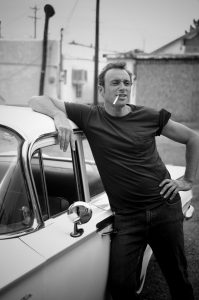By D.C. Bloom
Longtime fans of the wildly prolific folk singer Dan Bern may have believed the rest of the world was finally catching on when those “Feel the Bern” t-shirts starting popping up among the in-crowd during the summer of 2015. But alas … while supporters of a certain feisty democratic socialist senator/presidential hopeful from Vermont would probably find some of Bern’s more stridently political offerings right up their leftish alley (“Bush Must be Defeated;” “Talkin’ Tea Party Blues;” “Osama in Obamaland;”), the singer-songwriter remains a tragically under-appreciated and largely under-the-radar artist on the Americana scene, still metaphorically polling in single digits, even after years on the folk scene stump and more than two dozen critically-acclaimed releases.
The Bern discography is a testament to the Iowa native’s relentlessly firing creative synapses; if this guy has ever suffered from writer’s block, it probably wasn’t for more than an hour of so. In addition to the 25 albums and EPs he’s released over the past 18 years, he’s written songs for both the movie Walk Hard: The Dewey Cox Story and the new Amazon cartoon series, The Stinky and Dirty Show, and authored two novels: 2004’s Quitting Science (under the nom de plume Cunliffe Merriweather) and this year’s 10,000 Crappy Songs & Other Tales of Detection. He’s also painted scores of artful canvases that double as incentives and rewards for loyal fans and benefactors, and even managed to incur the wrath of the man he’s playfully referred to as “the Dan Bern of the ’60s.” (You can read all about it in Bern’s hilarious recent Salon.com article, “Bob Dylan called me a ‘scurrilous little wretch with a hard-on for comedy.'”)
Yes, Dan Bern is, indeed, one prolific mofo. And if life and art were fair, he might even be right up there today on folk music’s Rushmore with Woody, Bob, Bruce and Prine, just as his early next-big-thing buzz seemed to indicate. Critics and peers alike took immediate notice of his formidable skills. “His songs just come in from left field, and he always hits home runs,” marvels Texas songwriter and longtime Bern fan Terri Hendrix, who readily cites “Jersusalem,” the opening track from Bern’s self-titled 1997 full-length debut, as “a masterpiece that keeps me hooked.” Ani DiFranco was hooked early on, too, taking Bern on tour with her and producing his second album, 1998’s Fifty Eggs. But a seismic shift in the terra firma of the music industry right about that time all but doomed Bern’s chances of ever breaking onto the mainstream radar.
“I was one of those guys who was around for a long time and a gatekeeper kind of said, ‘Ok,’ and then shortly after that is when it all disappeared,” Bern says. “So I was in a position there for a while of going, ‘Oh, what the hell do I do now?’ But you can’t sit around doing that for very long.”
Instead, Bern got busy doing what every artist not named Taylor Swift must do these days to make a living wage in the music business: hustle and diversify. He’s spent the better part of the last 20 years expressing himself in various creative ways while continuing to crank out album after album and hoping the music finds receptive ears. “It’s like working in the underground,” he reflects. “I’m always surprised and glad when anyone finds me.”
His latest album, Hoody, makes the strongest case yet for Bern’s candidacy for the pithiest, most prescient voice on the 21st century folk scene. It’s also arguably his most accessible to listeners who aren’t already dedicated followers of all things Bern.
“I feel it’s a style of music that can appeal to a lot of people,” says Bern. “Hoody has the three strands of music and songs that we’ve been dipping into for a long time: the old classic country; the kind of British rock ’n’ roll; and old folk and blues. For whatever reason, this one feels like it has a nice balance of that, without everything fighting everything. Hoody kind of brings it all together.”
Bern establishes the country bona fides with “Merle, Hank and Johnny,” a T-for-Texas-laced homage to the beer-stained and sequined saints of county complete with a name-dropping chorus with referencing George Jones and Jimmie Rogers, two of the Lone Star State’s finest contributions to the genre, native and adopted. And though Bern’s never been one to have to pad an album with other’s material, Hoody also finds him tackling a rare cover, channeling Johnny Cash a la Hank Snow on “One Piece at a Time.”
Hoody also finds Bern playing the political on “Waffle House,” expounding on his theory that a state’s proclivity to go either red or blue is somehow linked to the number of, well, Waffle Houses it houses. And there’s the lovely, hopeful ballad “Sky,” which features the relentless optimism that has defined Bern throughout his career and forged his way forward: “Long as I can feel you breathin’ and see the sky above,” he sings, “I will walk my way as long as I can feel your love.”
Between the demands of fatherhood, seeking out music licensing opportunities and his innovative use of the web to reach fans worldwide via his popular online “Theme Park” shows (streaming concerts in which he culls his massive catalog for songs fitting specific themes), Bern has scaled back his once relentless touring pace in recent years. But he still pines for the thrill of entertaining audiences in person, and aims to see a lot more of the open road in the near future. As he sings on his new album’s title track, “I got my GPS and my hoody,” and he’s ready to put both to the test. He explains the lure with a nod to the legendary Texas bluesman, Lightnin’ Hopkins.
“I love thinking about that guy sitting around the house in Houston with friends playing cards, with women and whiskey, and when the money got low, he’d pack up his guitar and go play some shows and bring it all back home again,” Bern muses. “For a whole long time that was the image of all I wanted to do.”







Thank you for this splendid article on the criminally underappreciated artist. Great words about a truly great musician!
Excellent article. I have been following him and his music since 1997. Always happy to see him get the recognition he deserves.